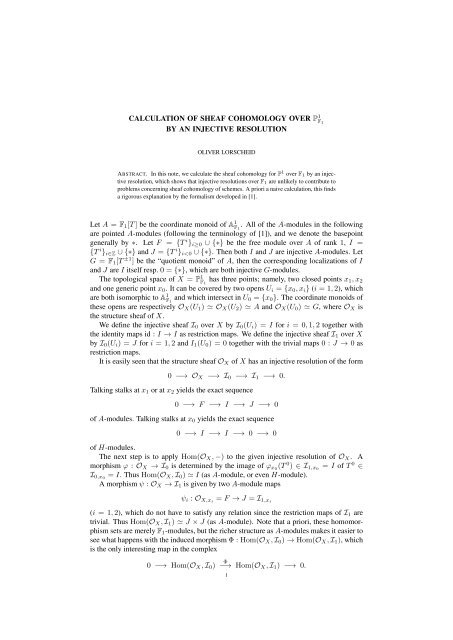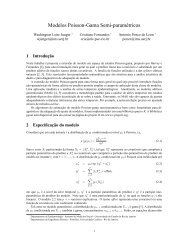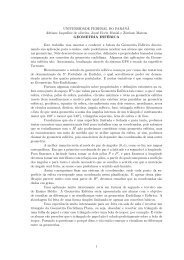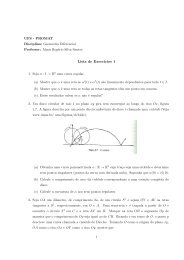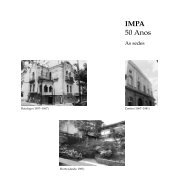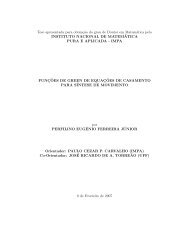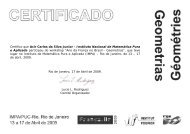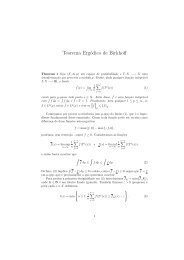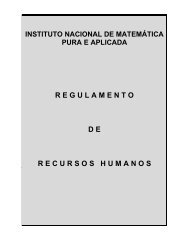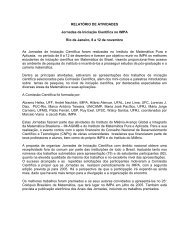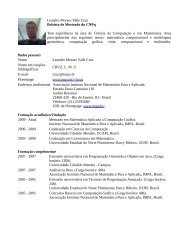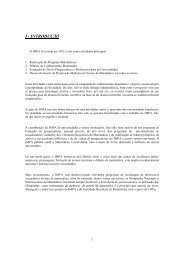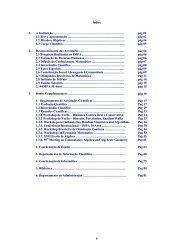CALCULATION OF SHEAF COHOMOLOGY OVER P1 BY AN ... - Impa
CALCULATION OF SHEAF COHOMOLOGY OVER P1 BY AN ... - Impa
CALCULATION OF SHEAF COHOMOLOGY OVER P1 BY AN ... - Impa
You also want an ePaper? Increase the reach of your titles
YUMPU automatically turns print PDFs into web optimized ePapers that Google loves.
<strong>CALCULATION</strong> <strong>OF</strong> <strong>SHEAF</strong> <strong>COHOMOLOGY</strong> <strong>OVER</strong> P 1 F 1<br />
<strong>BY</strong> <strong>AN</strong> INJECTIVE RESOLUTION<br />
OLIVER LORSCHEID<br />
ABSTRACT. In this note, we calculate the sheaf cohomology for P 1 over F 1 by an injective<br />
resolution, which shows that injective resolutions over F 1 are unlikely to contribute to<br />
problems concerning sheaf cohomology of schemes. A priori a naive calculation, this finds<br />
a rigorous explanation by the formalism developed in [1].<br />
Let A = F 1 [T ] be the coordinate monoid of A 1 F 1<br />
. All of the A-modules in the following<br />
are pointed A-modules (following the terminology of [1]), and we denote the basepoint<br />
generally by ∗. Let F = {T i } i≥0 ∪ {∗} be the free module over A of rank 1, I =<br />
{T i } i∈Z ∪ {∗} and J = {T i } i
2 OLIVER LORSCHEID<br />
The homology groups of this complex are F 1 -vector spaces that we interpret naively as<br />
H i (P 1 , O X ).<br />
The kernel of Φ consists of the trivial morphism and the morphism ϕ : O X → I 0 that<br />
is characterized by ϕ x0 (T 0 ) = T 0 . Thus H 0 (P 1 , O X ) = {∗, ϕ} is an 1-dimensional F 1 -<br />
vector space, in accordance with the analogous result for sheaf cohomology of P 1 over a<br />
ring.<br />
The image of Φ are morphisms ψ : O X → I 1 such that either ψ 1 or ψ 2 is trivial. Thus<br />
imΦ = J ∨ J ⊂ J × J (as A-modules). Consequently H 1 (P 1 , O X ) = (J × J)/(J ∨ J)<br />
is an infinite-dimensional F 1 -vector space. This result is not at all in coherence with the<br />
situation over a ring where H 1 (P 1 , O X ) = 0.<br />
Remark: The above calculation can also be used to calculate “candidates” H i (P 1 , O(n))<br />
for the twists O(n) of the structure sheaf, which yields the expected outcome for H 0 ,<br />
namely, an F 1 -vector space of dimension n + 1 if n ≥ 1 and 0 if n < 0, but which yields,<br />
again, an infinite-dimensional F 1 -vector space H 1 (P 1 , O(n)).<br />
Remark: As explained to me by Anton Deitmar, this does not contradict Theorem<br />
2.7.1 in [1], which implies that the rang of cohomology over F 1 is at most the rang of the<br />
corresponding cohomology over Z. The reason is that the base extension of the twisted<br />
sheaf O(n) to Z (in the sense of [1]) is not the twisted sheaf on the projective line over Z,<br />
but a sheaf on P 1 Z that is not of finite type.<br />
To explain, the definition of the base extension of a sheaf F on an F 1 -scheme X to the<br />
associated scheme X Z is the pullback π ∗ F along the base extension map π : X Z → X.<br />
This differs, in particular, to the definition given in [2]. Here, the base extension of F to<br />
X Z is defined as the tensor product π ∗ F ⊗ π∗ O X<br />
O XZ of the pullback with the structure<br />
sheaf of X Z . In this case, the base extension of the twisted sheaf over P 1 F 1<br />
is indeed the<br />
twisted sheaf over P 1 Z , but, clearly, any comparison of cohomology groups breaks down.<br />
REFERENCES<br />
[1] A. Deitmar. Belian Categories. Preprint, arxiv:1105.5290v1, 2011.<br />
[2] C. Chu, O. Lorscheid, R. Santhanam. Sheaves and K-theory for F 1 -schemes. Adv. Math. 229, no. 4, 2239-<br />
2286, 2012.


